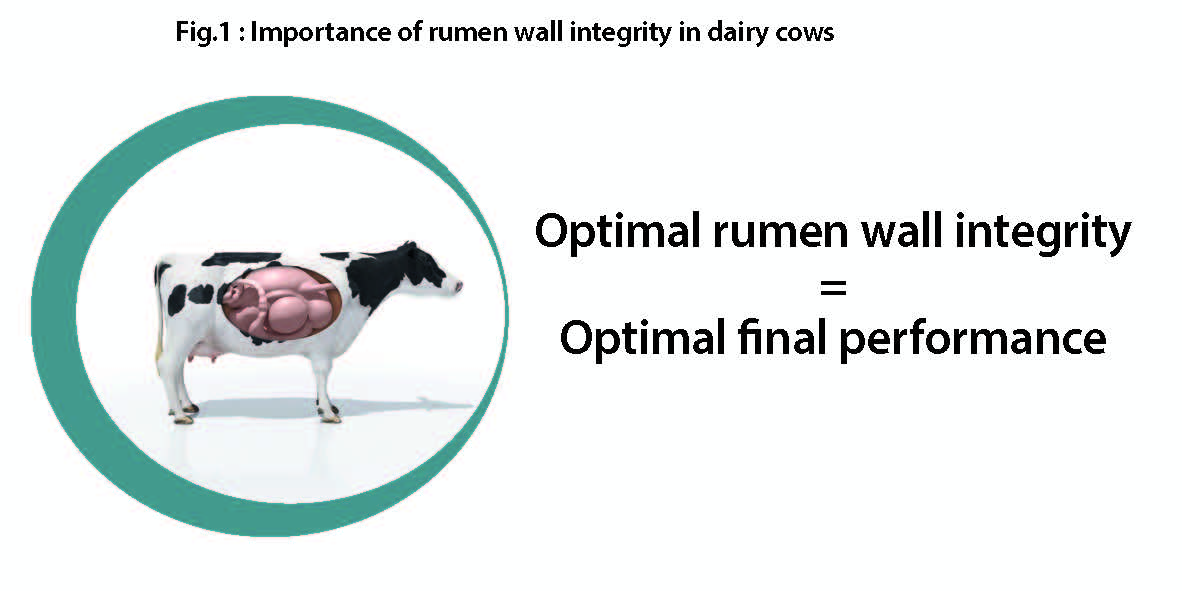Blog | Reading Time 3 minutes
Optimizing dairy cow performance: The role of rumen wall integrity
Rumen health is essential for an efficient and productive dairy herd. Maintaining the integrity of the rumen wall is key to ensure dairy cows performance and welfare and can have benefits throughout their whole life cycle.
Get more milk from cows with good rumen wall integrity
Optimal rumen health is crucial for dairy cow success, influencing nutrient digestion and overall well-being and milk production. Over half of cattle exhibit varying degrees of rumen wall damage, which correlates to decreased milk yield. Research indicates that cows with good rumen wall integrity can produce significantly more milk compared to those with rumen defects. The lesions observed can vary from rumen inflammation to parakeratosis and ulcers. Damage is prevalent even in low-risk environments like extensive grazing. Prioritizing rumen health throughout an animal’s life is essential for maintaining dairy herd well-being, efficiency and productivity (Figure 1).
Feed management and environmental factors can disrupt rumen microbiota balance and damage the lining, Increasing the risk of SARA which may ultimately lead to acidosis. Studies highlight the significance of the rumen’s microbiota in converting dietary polysaccharides into volatile fatty acids. A healthy rumen wall absorbs 88% of these energy-providing acids. In case of SARA, this energy production and absorption is disrupted.
Our research on rumen wall integrity
Our recent research in France and Australia indicates that rumen wall damage is prevalent in both intensive and extensive ruminant farming systems, affecting dairy and beef cattle alike, with more than 50% of animals showing signs of rumen acidosis to a lesser or greater extent with consequence on performance.
The Australian study specifically found a 7% decrease in milk yield for cows with rumen damage compared to those with healthy rumens, equating to a substantial 500kg loss in annual milk production per cow. These findings underscore the importance of maintaining rumen wall integrity, even in grass-based diets, to ensure efficient energy absorption and optimal dairy performance (Figure 2).
What causes damage to the rumen wall?
Disruptions — such as dietary changes and stress — can lead to rumen wall damage, affecting nutrient absorption. Sub Acute Ruminal Acidosis (SARA), a major cause of this damage, occurs when cows experience prolonged low rumen pH levels, below 5.5-5.6, often due to diets high in fermentable carbohydrates and low in fiber. This causes a pH drop in the rumen, which negatively affects the bacteria balance at a microbiota level. It can compromise the rumen’s natural barriers, leading to a “leaky” rumen wall allowing toxins and undesirable bacteria enter the bloodstream and potentially causing inflammation. One visual signs of those inflammations can be seen in feet (lame cow) or horns (red horns). Maintaining rumen health is therefore essential to preventing SARA and maintaining animal in good conditions which helps ensure its productivity.
Managing rumen wall integrity
Ensuring the integrity of the rumen wall from weaning is crucial for the lifelong performance of ruminants. Our rumen-specific live yeast Saccharomyces cerevisiae CNCM I-1077 (LEVUCELL SC) has been scientifically proven to improve rumen microbiota balance, development and function. It works by maintaining stable pH levels, reducing lactic acid and fostering beneficial microbes. In turn, these actions promote the development of the rumen epithelium and papillae, increasing the absorption surface by 14%. This early investment in rumen health, particularly in young dairy heifers, leads to better nutrient absorption and overall well-being.
Additionally, LEVUCELL SC aids to protects the rumen during stressful periods when the priority is to help rumen microbiota resilience to changes, for example, that may occur during transportation, heat stress, mixing of social groups, turnout to grass or dietary changes. Using such nutritional tool, in combination to other feeding best practices, can helps ensure a resilient and productive herd.
Published Jul 23, 2024 | Updated Sep 10, 2024
Related articles
Need specific information?
Talk to an expert
